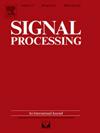Efficient homography estimation using a recursive algorithm with a mixture of weighted Gaussian kernels
IF 3.4
2区 工程技术
Q2 ENGINEERING, ELECTRICAL & ELECTRONIC
引用次数: 0
Abstract
In this study, we propose an efficient recursive algorithm, named GK-RLS, defined with a mixture of weighted Gaussian kernels for efficient homography estimation. By defining the homography estimation problem as a least square problem and optimizing the estimation parameters based on minimizing expected estimation errors, GK-RLS offers efficient incremental processing of feature points, rather than processing them as a batch like RANSAC, resulting in reduced computation time (CT) when handling a large number of paired features. To address real-world challenges such as noise and outliers commonly encountered in feature extraction and pairing, GK-RLS incorporates a small-pass filter defined with Gaussian kernels to effectively attenuate their resulting large prediction errors, thus reducing outlier drawbacks. The algorithm's effective stopping criteria are established based on a concept akin to RANSAC, with termination occurring when the estimated homography matrix yields low geometric error for a predefined portion of paired feature points. The CT of the algorithm is crucial for online applications or scenarios requiring the sharing of feature data points within communication networks, such as between multiple drones or between drones and a ground station. Therefore, leveraging the iterative structure and effective stopping criteria of GK-RLS, it estimates the homography matrix using only a limited number of feature points, resulting in a smaller CT compared to RANSAC while having a similar estimation performance. Extensive evaluations, including sensitivity analysis, a drone simulation, and experimental implementation, demonstrate the superiority of GK-RLS over RANSAC, especially concerning the required CT. Overall, GK-RLS presents a promising solution for robust and efficient homography matrix estimation in various real-world scenarios that require process data in high sampling frequencies.
求助全文
约1分钟内获得全文
求助全文
来源期刊

Signal Processing
工程技术-工程:电子与电气
CiteScore
9.20
自引率
9.10%
发文量
309
审稿时长
41 days
期刊介绍:
Signal Processing incorporates all aspects of the theory and practice of signal processing. It features original research work, tutorial and review articles, and accounts of practical developments. It is intended for a rapid dissemination of knowledge and experience to engineers and scientists working in the research, development or practical application of signal processing.
Subject areas covered by the journal include: Signal Theory; Stochastic Processes; Detection and Estimation; Spectral Analysis; Filtering; Signal Processing Systems; Software Developments; Image Processing; Pattern Recognition; Optical Signal Processing; Digital Signal Processing; Multi-dimensional Signal Processing; Communication Signal Processing; Biomedical Signal Processing; Geophysical and Astrophysical Signal Processing; Earth Resources Signal Processing; Acoustic and Vibration Signal Processing; Data Processing; Remote Sensing; Signal Processing Technology; Radar Signal Processing; Sonar Signal Processing; Industrial Applications; New Applications.
 求助内容:
求助内容: 应助结果提醒方式:
应助结果提醒方式:


